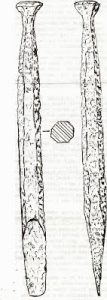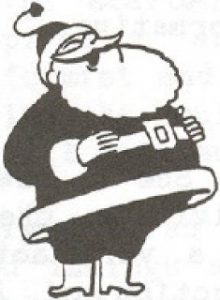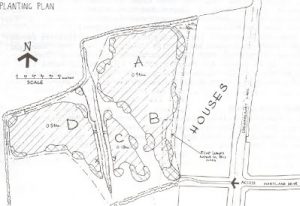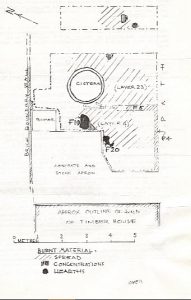ISSUE NO.270 SEPTEMBER 1993 Edited by Andy Simpson
Friday to Sunday, 3-5 September: CHESTER AND LLANDUDNO WEEKEND
Saturday 18 September: MUSEUM OF LONDON – Private viewing of Brockley Hill pottery plus talk and walk with Francis Grew (details and application form enclosed.)
Tuesday 5 October: “ASPECTS OF ROMAN POTTERY” – Dr Robin Symonds. First in new series of HADAS lectures.
Saturday 16 October: MINIMART – at St Mary’s Church House, Hendon. Members with items to donate please contact Dorothy Newbury (203 0950).
Tuesday 2 November: “FUN AND GAMES IN THE ROMAN BATHS” – mark Hassall, FA Institute of Archaeology.
Saturday 6 November: VISIT TO ST PAUL’ CATHEDRAL with Mary O’Connell.
Tuesday 7 December: CHRISTMAS DINNER at University College, Gower Street.
Tuesday 11 January, 1994: Afternoon midweek visit to the Newspaper Library, Colindale NW9. This was advertised in the “British Library Newsletter” (via Ann Kahn). Visits have to be arranged in advance, so please phone Dorothy Newbury (203 0950) if you might be interested.
THE CALL OF THE WILD by Roy Walker
In the July 1991 Newsletter the HADAS Committee posed the questions “What does archaeology mean to you … what is it that especially draws you to archaeology?” Two years later at the Church Farm House excavation I have been reminded of those questions when memories of my introduction to archaeology were aroused. Nearly thirty years ago when still at school, I attended a lecture on natural history organised by the South London Field Studies Group. It turned out that the Group’s activities encompassed more than natural history – archaeology and even caving were included – but the countryside was the underlying theme.
CFM93 is a rural excavation. There’s a pond in the south west corner, a farmhouse to the south, a country church to the east, two public
houses around the corner, and the rolling fields of Hertfordshire to the north. And there are the frogs. Many frogs. Instinct dictates that when tadpoles gain their adult form they vacate their birthplace and seek pastures new, but at Church Farm most got no further than our trenches which necessitated a daily frog-renewal programme as a first priority. It is an uncomfortable feeling putting an arm down a posthole and coming up with a handful of 5mm frogs rather than a sherd of Hertfordshire greyware. And there are also the newts – not as plentiful as frogs but enough to warrant their removal from outside the door to the cellar, our excavation office.
And there’s Henry, the Museum curator’s four-years-old ginger tom. A sleek hunter who stalks the hedgerows and long grasses around his home, often returning with a dead mouse hanging limply from his mouth.
He was once seen carefully walking home with a dead rat. It’s not surprising that we have only seen one squirrel during the two months we have been on site. An injured dormouse, perhaps an escapee, found one morning sheltering outside the cellar in a state of shock, had to be removed to a safer place by a considerate excavator.
There are also the wild flowers, growing again within the fenced–off excavation area, safe from the weekly grass-cutting. My newly-acquired field study hobby had rather quickly concentrated on the narrow field of archaeology so botany faded into the background. May I suggest that members who are familiar with field and meadow plants pay a visit to the excavation and help finish this article by providing a flora list as my knowledge of this subject is very limited. Did someone mention archaeobotany?
(Visitors should also keep an eye open for Caesar, an extremely people-friendly moggy who has taken to “helping” down some of the trenches he just loves a nice post hole to stick his head down: Ed.)
ST ALBANS CELTIC BURIAL SITE by Bill Bass
Following the discovery and excavation of the important Celtic burial at Folly Lane (see Newsletter 263 and “Current Archaeology” 132), the team from St Albans Museum Unit have continued to dig this summer with recent uncovering of buildings from the sub-Roman “Dark Age” period.
These wooden structures were excavated a short distance outside the north gate of Verulamium close to the St Albans/Colchester Road. The once-busy road is still very much in evidence and has traces of cart tracks running through it.
Remains of substantial corner posts mark out buildings which are approximately dated to the 5th century. Their purpose has not yet been established, but some of them seem to have fenced yards next to them and a number of small bread ovens and broken querns for grinding corn have been discovered.
In the adjacent area rubbish pits are being sieved, soil samples have been taken in the hope of extracting pollen and other environmental data.
There are many difficulties in interpreting and dating the sub-Roman 5th century period. Verulamium is thought to be one of the longer surviving Roman settlements, and any information or archaeological evidence for continuing occupation or possible Saxon settlement would be useful.
Ros Niblett (Keeper of Field Archaeology): “The presence of these buildings is interesting because their position outside of the Roman city walls would indicate that there was a period of relative peace and security in the city enough to make people feel safe to live or work outside it.”
The main excavation is now finished, but the St Albans Archaeological Society will take over the site before developers start work.
(Article based on a report from the “St Albans Review.”)
MEANWHILE, IN EAST ANGLIA … by Andy Simpson
Also in the news recently were two important Roman sites in Eastern England. The tribal capital of the Iceni, Venta Icenorum, close to the modern village of Caistor St Edmund, is one of only three major towns in Roman Britain not to have been built over, the others being Wroxeter and Silchester – Venta Icenorum being reduced by the “new town” of Norwich two miles away, and the site reverting to farmland.
This summer a new £90,000 visitor centre will open and guided walks are planned by the current owners of the site, the Norfolk Archaeological Trust, who were bequeathed the site by its last owner in 1984. Traces of the city defences – ditch, bank and wall – are still visible, one bastion still standing 10 feet high, with stretches of the north wall still standing 20 feet high. Early air photos taken in 1928 showed the street pattern surviving and caused quite a sensation at the time.
Also in the news this summer are the remains of a small Roman town in Norfolk not far from Venta Icenorum. Excavations at Scole on the site of the A140 Scole/Dickleburgh bypass have revealed traces of a settlement thought to be Villa Faustini, a staging-post between Colchester and Venta Icenorum. The excavation has uncovered the industrial outskirts of the settlement, with traces of a tannery, iron-smelting, lead-moulding and a smithy.
Waterlogged peat on the site has preserved two half-finished wooden bowls, thought to be unique in Britain. Traces of a Roman canal have also been found, cut beside the River Waveney which crosses the site.
A MAMMOTH FIND IN THE ENGLISH COUNTRYSIDE
(Not my title – blame the “Daily Mail” – Ed.) Excavations at Eynsham, near Oxford have, in an area of only 25 square yards, revealed the remains of up to 20 mammoths – 13 tusks, 8 teeth and 60 bones, within this quarry site. The bones are some 200,000 years old and prove for the first time that woolly mammoths lived in warm as well as ice age climates. Environmental evidence suggests that the climate then was slightly warmer than that in Britain today. It is thought that the animals were caught in a flood and drowned in mud, preserving their remains remarkably well. Other remains found include horses and bison. It is thought many more remain to be discovered on the site.
Whilst on the subject of fossils, the soft, sea-eroded cliffs near Lyme Regis have recently yielded the bones of a 12-foot long ichthyosaur, unusual in being a long-jawed type, with small teeth for catching small fish or filtering plankton. The skeleton is virtually intact, apart from the tail. The finder of this Jurassic creature of 195 million years ago runs a local museum – Dinosaurland.
PROFESSOR W .R. GRIMES – 1905-1988 TED SAMMES
The latest number (Vol 39) of the Transactions of LAMAS carries a tribute to his life’s work by Jenny Hall and Jean Macdonald. Inevitably such a tribute on five pages can only touch on his many activities, and it is worthwhile to remind ourselves that he was our President from 1965 till his death on December 25th 1988, aged 83.
He led a very active life, and one can only wonder for how many other local societies he was a mentor and president. An appreciation of him appeared in our Newsletter No.215, February 1989, under the title “Peter Grimes – the First Rescue Archaeologist.” This originally appeared in “The Times” and was by our Chairman, Andrew Selkirk.
PAST HENDON DIGS 1961-74 TED SAMMES
To complement the present excavations in the rear garden of Church Farmhouse Museum, Hendon, Ted Sammes, Victor Jones and Gerrard Rootes have arranged an exhibition upstairs in the small room of the Museum.
It covers finds in the range Roman to Post-Medieval from:-
1961-66 Church End Farm, Hendon, now partly under the rear of
the University;
1966 Sunny Gardens, Hendon – Roman cremation urn.
1972 Burroughs Gardens, nearly opposite the “White Bear” pub
1973-74 Church Terrace, where the Meritage Centre now stands.
This exhibition is timed to coincide with National Archaeology Day on August 29. None of these finds have been seen since our 25th year commemorative exhibition in 1986. This emphasise yet again the need for an exhibition area in which a changing display of finds in possession of HADAS and others can be displayed.
Please make an effort and visit both the excavation and the Museum.
Please note the Museum is now closed on Fridays, but open Monday to Saturday 10 – 1 pm and 2 – 5 pm. On Sundays it is open from 2 – 5.30 pm. Admission is free.
SOMETHING FOR THOSE AUTUMN EVENINGS …
As the evenings begin to draw in once more, members may be tempted by some of the evening courses available locally.
The Hampstead Garden Suburb Institute are running “An Insider’s View of Egyptian Culture” led by Okasha Eldaly, BA. This runs for 11 meetings on Tuesdays from 28th September, fee £31.00, or £10.00 retired/unwaged/ low-waged. The course looks at 8,000 years of Egyptian civilisation and continuity and integrity of the culture – administration, social structure, art and religion.
HADAS member Jack Goldenfeld, who is also a stalwart of Barnet Museum, reminds us that he is running his course “Glimpses of the Past – An Introduction to Archaeology” at two centres this year: West Herts College, Watford and Elm Park College, Stanmore. The course is for three terms and aims to develop an awareness of the past and how it shaped the
present, looking at selected archaeological sites on all five continents. The West Herts course starts 20th September, full fee £48.20 per term; the Elm Park course starts 30th September, full fee £35.00 per term; Details from Jack on 0923 285225 or West Herts 0923 255533, or Elm Park 081-954 9481.
OR LATE SUMMER AFTERNOONS
Members may also be interested in the exhibition “Knyghthode and Batayle – Medieval Warfare through the Ages” at the British Library until. September 26th, weekdays 10-5, Sundays 2.30-6, at Great Russell Street. Medieval manuscript illustrations are used to show the practice of warfare and other aspects.
MEMBERSHIP NEWS
This month we greet another four new members: Tom Real, David and Sian Plant who all joined HADAS after digging with our team at Church Farm House Museum, also Aileen Cotton (who joined us on the Ely trip.)
Resignations have been received from Joanna Wade, who sends her best wishes for the Society, and from Mr and Mrs Jeyes and Dr S Natelson who all have other priority commitments and interests.
Church Farmhouse excavation
At the time of writing 16th August 1993 we can say that excavation has taken the story of farming at Church Farm back beyond the documentary history of the farmhouse (and indeed the church) to something like AD1100. In two places, our exploratory trenches have exposed horizons yielding medieval pottery of that sort of date.
One of these is an area of massive wood burning in a depression in the natural sandy subsoil. We don’t know the area of it – it extends either side of our 2 metre wide trench; it could simply be a bonfire lit in a hollow scooped out of the ground, perhaps for porfiring or perhaps the burnt remains of a wooden structure. It give a general impression of the firing of quite substantial timbers.
The other is an area of greenish-yellowing soil, lying immediately above the natural sand, which we interpret as a farmyard surface impregnated with animal droppings. We have so far exposed an area of about four square metres and hope that more of it will appear as we get deeper into other parts of the trench. So far, the artefacts found on the surface of this layer have been exclusively no later than medieval.
We are nearing the end of our time allowed on site this year and will obviously have to backfill before we explore further. However we may hope that we will be allowed to return in the future and we shall be able, I think, to report to the Borough that whilst the work so far shows there is certainly some archaeology here to be further explored. It appears to lie sufficiently deep not to be disturbed by continuing as a garden. However if in refurbishing the garden there is to be any substantial earth moving (ie building wheelchair access, or regarding the slope) there should be prior archaeological assessment of the area involved.
Brian Wrigley.
As we reach the end of our season at Church Farm, levelling and section drawing are receiving particular attention. On site processing of finds is also making good progress. Finds of quite large sherds of Herts Greyware and pottery of a similar date continue to be made, all mixed in with a remarkable quantity of broken tile. There still seems to be a remarkable scarcity of 16th – 17th century material compared to the quantities of medieval and Victorian/modern material recovered – and still not a coin of any date! The acid nature of the sandy subsoil also means that very little bone survives from the medieval levels. – Ed.
Crofton Roman Villa description omitted
FORTHCOMING ARCHAEOLOGICAL COURSES
The following archaeology courses are advertised in “Floodlight”. For further details either write or ‘phone course enquiry office numbers below – (not all at course venues).
Type of course Location
General Kens & Chelsea (eve) Morley Birkbeck
Anglo-Saxon Morley (eve)
British City Lit Morley
British Norman/Viking City Univ (eve)
Early London Morley (day)
Egypt Kens & Chelsea (eve) Kingsway (Haverstock Hill) (eve)
City Lit Birkbeck (Russell Sq)
City Univ, Northampton Square (eve) Goldsmiths’ (eve)
Greek Kens & Chelsea (eve) Birkbeck City Univ (eve)
Arch & history: Ancient Near East Kingsway, Regents Pk (day)
Industrial City Lit (day) Morley (eve) City Univ (eve)
Roman City Univ (eve)
Western Asia Morley (eve)
Univ of London Extra-Mural Diploma City Lit Morley Birkbeck
Univ of London Cert/Diploma Field Archaeology Birkbeck
Kensington & Chelsea College, Fox Branch, Edge Street W8 7PN 081-964 1311 or 071-351 7127
Kingsway College, Regents Pk Centre, Longford St, NW1 3HB 071-306 5700
Kingsway College, Haverstock Hill, NW1 071-306 5700
City Lit, Stukeley Street, Drury Lane, WC2B 5LJ 071-242 9872
Morley College, 61 Westminster Bridge Road, SE1 7HT 071-928 8501
Univ of London, Birkbeck College, 26 Russell Square, WC1B 5DQ 071-631 6633
City University, Northampton Square, EC1V OHB 071-477 8000 ext 3268/3179/3253
Goldsmiths’ College, Lewisham Way, SE14 6NW 081 692 7171 ext 8000






